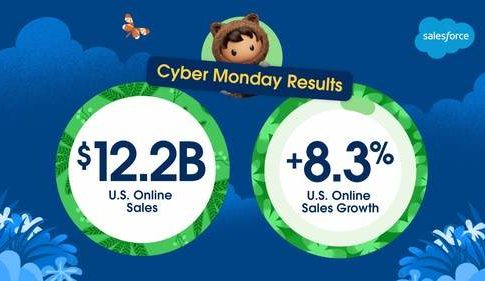Salesforce (NYSE: CRM), the global leader in CRM, today unveiled its 2022 Cyber Week figures, analyzing shopping data from over 1.5 billion shoppers on the Salesforce Customer 360 and activity across commerce, marketing, and service (including 24 of the top 30 U.S. online retailers). Overall, 2022 global online sales hit an all-time high of $281 billion, up 2% compared to 2021, and $68 billion in the U.S., up 9% compared to 2021.
The data showed a departure from Cyber Weeks in 2020 and 2021, when online shopping was increasingly spread throughout the month of November. In comparison, 2022 data show both shoppers and retailers held out for Cyber Week as retailers worked to limit discounts that increased margin pressures and consumers searched for better deals – contributing to the largest spike in U.S. digital sales growth in the last six weeks.
Top Cyber Week 2022 Salesforce shopping insights
- Online sales and digital traffic break records despite economic uncertainty: Despite many retailers reporting lighter foot traffic, online sales across Cyber Week reached $281 billion globally (a 2% increase YoY) and $68 billion in the U.S. (a 9% increase YoY).
- While Europe and the UK results showed continued economic headwinds, U.S. sales buoyed global online sales growth throughout Cyber Week.
- Social media referrals hit an all-time high: The majority (76%) of Cyber Week ecommerce traffic came through mobile devices, with social media referring nearly 10% – a 22% increase YoY and the highest referral percentage ever seen during the holiday season based on Salesforce data.
- The “discount chicken” game is over: After lackluster deals early in the holiday season, average discount rates spiked during Cyber Week, topping pre-pandemic levels at 27% globally and 30% in the U.S.
- Following a steady incline over the last seven quarters, the global average selling price (ASP) finally leveled off during Cyber Week, rising 3% compared to 2021. The rate of cart abandonment also dropped 5% globally during Cyber Week compared to the previous three weeks as consumers took advantage of big discounts.
- The top discount categories globally were:
- General Apparel (34%)
- Makeup and Skincare (32%)
- Luxury Handbags and Apparel (26%)
- BOPIS adoption increases: With convenience a top priority for consumers, Buy Online and Pick Up In Store (BOPIS) and curbside pickup helped shoppers avoid long lines. Cyber Week BOPIS usage grew 9% globally Thursday through Sunday compared to the first three weeks of November. Retailers in the US that had BOPIS grew online revenue by 38% more than those without this creative fulfillment option throughout Cyber Week.
- Consumers stretch their dollars with BNPL: Amid inflationary pressure and shrinking budgets, U.S. shoppers utilized alternative payment options like Buy Now Pay Later (BNPL) to finance purchases – with a 5% increase in orders YoY. However, the average order value for U.S. BNPL transactions across Cyber Week decreased 5% — indicating shoppers financed lower-priced goods this year compared to 2021.
- Automation gave time back to retailers and consumers: Retailers leaned into automation on some of the biggest online shopping days of the year, saving agent time for complex order servicing issues and driving customer loyalty. Chatbot messages globally increased 57% on Black Friday and 53% on Cyber Monday compared to the same days in 2021.

The Salesforce perspective
- “After lackluster discounts earlier in the season, retailers stepped up their game throughout Cyber Week, and shoppers answered in kind. Our data shows an incredibly strong correlation between discount rates and digital sales as consumers held out for the biggest and best deals,” said Rob Garf, Salesforce VP and GM, Retail.
- “As we enter the home stretch of the holiday season, retailers must preserve margins by emphasizing automation to balance operational efficiency and customer loyalty. We anticipate that the retailers who lean into store fulfillment, personalize service, and streamline returns will be winners and find more success now,” Garf continued.





